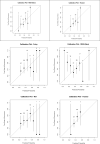Validation of prognostic indices for short term mortality in an incident dialysis population of older adults >75
- PMID: 33471808
- PMCID: PMC7816982
- DOI: 10.1371/journal.pone.0244081
Validation of prognostic indices for short term mortality in an incident dialysis population of older adults >75
Abstract
Rational and objective: Prognosis provides critical knowledge for shared decision making between patients and clinicians. While several prognostic indices for mortality in dialysis patients have been developed, their performance among elderly patients initiating dialysis is unknown, despite great need for reliable prognostication in that context. To assess the performance of 6 previously validated prognostic indices to predict 3 and/or 6 months mortality in a cohort of elderly incident dialysis patients.
Study design: Validation study of prognostic indices using retrospective cohort data. Indices were compared using the concordance ("c")-statistic, i.e. area under the receiver operating characteristic curve (ROC). Calibration, sensitivity, specificity, positive and negative predictive values were also calculated.
Setting & participants: Incident elderly (age ≥75 years; n = 349) dialysis patients at a tertiary referral center.
Established predictors: Variables for six validated prognostic indices for short term (3 and 6 month) mortality prediction (Foley, NCI, REIN, updated REIN, Thamer, and Wick) were extracted from the electronic medical record. The indices were individually applied as per each index specifications to predict 3- and/or 6-month mortality.
Results: In our cohort of 349 patients, mean age was 81.5±4.4 years, 66% were male, and median survival was 351 days. The c-statistic for the risk prediction indices ranged from 0.57 to 0.73. Wick ROC 0.73 (0.68, 0.78) and Foley 0.67 (0.61, 0.73) indices performed best. The Foley index was weakly calibrated with poor overall model fit (p <0.01) and overestimated mortality risk, while the Wick index was relatively well-calibrated but underestimated mortality risk.
Limitations: Small sample size, use of secondary data, need for imputation, homogeneous population.
Conclusion: Most predictive indices for mortality performed moderately in our incident dialysis population. The Wick and Foley indices were the best performing, but had issues with under and over calibration. More accurate indices for predicting survival in older patients with kidney failure are needed.
Conflict of interest statement
Dr.Tangri reports grants and personal fees from AstraZeneca Inc., personal fees from Otsuka Inc., personal fees from Janssen, personal fees from Boehringer Ingelheim and Eli Lilly, grants, and personal fees, and other from Tricida Inc., outside the submitted work. Study contents are the sole responsibility of the authors and do not necessarily represent the official views of NIH or the US government. This does not alter our adherence to PLOS ONE policies on sharing data and materials.
Figures
Similar articles
-
Validation of risk prediction tools in elderly patients who initiate dialysis.Int Urol Nephrol. 2019 Jul;51(7):1231-1238. doi: 10.1007/s11255-019-02160-y. Epub 2019 May 27. Int Urol Nephrol. 2019. PMID: 31134506
-
Prediction of Risk of Death for Patients Starting Dialysis: A Systematic Review and Meta-Analysis.Clin J Am Soc Nephrol. 2019 Aug 7;14(8):1213-1227. doi: 10.2215/CJN.00050119. Epub 2019 Jul 30. Clin J Am Soc Nephrol. 2019. PMID: 31362990 Free PMC article.
-
Predicting 6-Month Mortality in Incident Elderly Dialysis Patients: A Simple Prognostic Score.Kidney Blood Press Res. 2020;45(1):38-50. doi: 10.1159/000504136. Epub 2019 Dec 11. Kidney Blood Press Res. 2020. PMID: 31825925
-
Predicting Early Death Among Elderly Dialysis Patients: Development and Validation of a Risk Score to Assist Shared Decision Making for Dialysis Initiation.Am J Kidney Dis. 2015 Dec;66(6):1024-32. doi: 10.1053/j.ajkd.2015.05.014. Epub 2015 Jun 26. Am J Kidney Dis. 2015. PMID: 26123861 Free PMC article.
-
Prognostic indices for early mortality in ischaemic stroke - meta-analysis.Acta Neurol Scand. 2016 Jan;133(1):41-8. doi: 10.1111/ane.12421. Epub 2015 May 13. Acta Neurol Scand. 2016. PMID: 25968234
Cited by
-
Chronic kidney disease-related sarcopenia as a prognostic indicator in elderly haemodialysis patients.BMC Nephrol. 2023 May 19;24(1):138. doi: 10.1186/s12882-023-03175-5. BMC Nephrol. 2023. PMID: 37208625 Free PMC article.
-
Shared decision-making in advanced kidney disease: a scoping review.BMJ Open. 2022 Sep 21;12(9):e055248. doi: 10.1136/bmjopen-2021-055248. BMJ Open. 2022. PMID: 36130746 Free PMC article.
-
Predicting mortality in elderly chronic kidney disease patients using algorithmic risk assessment: a Southeast Asian perspective.BMC Nephrol. 2025 Aug 25;26(1):489. doi: 10.1186/s12882-025-04389-5. BMC Nephrol. 2025. PMID: 40855420
References
-
- Moss AH. Shared Decision-Making in the Appropriate Initiation of and Withdrawal from Dialysis. Clinical Practice Guideline. Rockville, MD: Renal Physicians Association; 2010.
Publication types
MeSH terms
Grants and funding
LinkOut - more resources
Full Text Sources
Other Literature Sources
Medical





